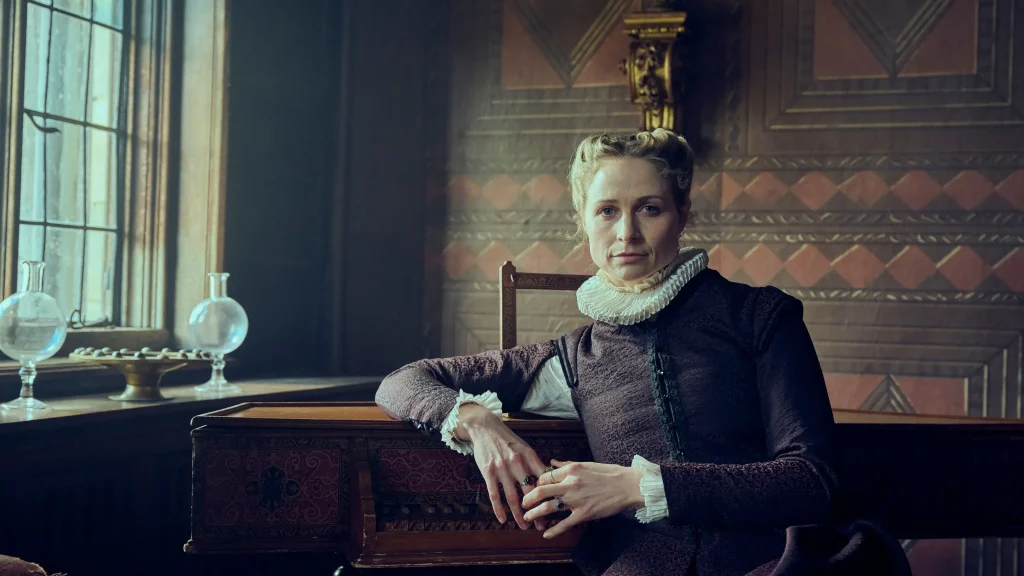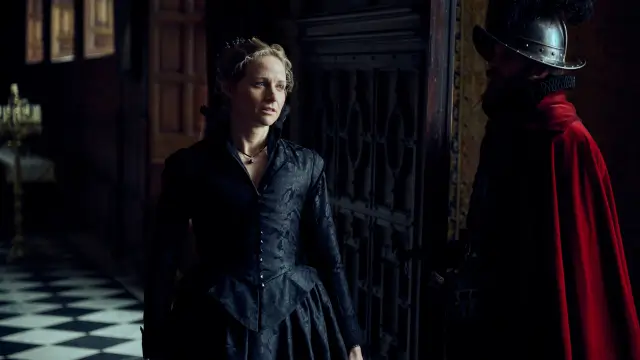In the Starz production, ‘Mary & George,’ a historical drama series, we meet Mary Villiers, a determined woman who marries Sir Thomas Compton to secure her social status. Alongside her, we encounter Sandie, a prostitute who becomes Mary’s trusted companion in her quest to capture the attention of King James VI and I.
‘Mary & George’ blends historical facts with creative storytelling, offering insights into the contrasting lives of nobility and commoners during this period. Creator D. C. Moore introduces Sandie as a fictional character, representing the struggles and aspirations of individuals from different social classes. Through Mary and Sandie’s unique relationship, the series explores themes of ambition, companionship, and societal constraints.
Although the romantic storyline between Mary and Sandie is fictional, it sheds light on the existence of marginalized voices in history, particularly queer women whose stories were often silenced. Actress Niamh Algar’s portrayal of Sandie brings depth to the narrative, emphasizing the importance of representation in historical storytelling.

Who is Sandie in the Mary & George? Is She Based on Real People?
Sandie plays a crucial role in Mary Villiers’ ambitious pursuits. When Mary marries Sir Thomas Compton to secure her social standing, she unexpectedly finds a companion in Sandie, a prostitute. Mary aims to catch the attention of King James VI and I to improve her fortunes through her son George Villiers, and Sandie becomes her trusted confidante. Together, they navigate the king’s court, strategically removing rivals like the Earl of Somerset and his wife, the Countess of Somerset.
In ‘Mary & George,’ inspired by historical events, creator D. C. Moore mixes in fiction, including the character of Sandie played by Niamh Algar. Sandie offers a view into 17th-century England, contrasting the lives of commoners and nobility. Moore explores class dynamics through Sandie, highlighting the differences in ambitions between a noblewoman like Mary and Sandie, who seeks security away from exploitation.
Historically, Mary Villiers did not have a same-sex relationship like the one with Sandie in the show. Moore created this relationship to show Mary’s interactions with men versus women, focusing on companionship and intimacy over transactions. This fictional queer romance sheds light on marginalized individuals in history, like queer women silenced by societal norms.
Sandie’s character in ‘Mary & George’ represents untold stories from the 17th century, where women’s histories were often overlooked. Actress Niamh Algar stresses the importance of this representation, showcasing independent queer women despite their absence in historical records. Through ‘Mary & George,’ history revisits marginalized figures from the past.
D. C. Moore explained Sandie’s role, saying, “I wanted some class analysis in this show, to see the different costs for people from different classes.” He further elaborated, “With men, she [Mary] has always been in a place where it feels transactional. She’s needed men to survive financially. She doesn’t feel she needs Sandie for anything but companionship, and that love and intimacy is something that Mary craves.”
This fictional portrayal not only entertains but also sparks discussions about identity, representation, and societal constraints in historical contexts.
Sandie’s character adds depth to the show by highlighting challenges faced by individuals from different social classes in 17th-century England. While Mary dreams of status and prestige, Sandie desires basic necessities like food and shelter, showing the disparity between the privileged and the marginalized. Through their unique relationship, the audience gains insights into human desires and aspirations in a stratified society.
Niamh Algar’s portrayal of Sandie resonates with modern audiences, emphasizing the importance of acknowledging marginalized voices in historical narratives. By blending fiction with historical context, ‘Mary & George’ invites viewers to explore untold stories of the past, deepening understanding of societal dynamics and personal motivations.
Must Read: Portuguese Horror Movie ‘Amelia’s Children’ Review












